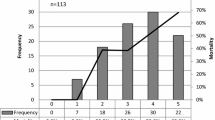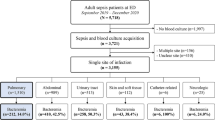Abstract
Background
Many studies have evaluated the clinical characteristics of Gram-negative bacteria (GNB) pneumonia. However, in most cases the bacteriological diagnosis is based on unreliable respiratory samples, and research rarely focuses on only bacteraemic patients. The aim of this study was to describe the incidence, clinical characteristics, outcomes, and factors associated with severity during the hospital stay of patients diagnosed with bacteraemic community-acquired pneumonia (CAP) due to GNB.
Materials and methods
Patients consecutively admitted with bacteraemic CAP due to GNB were enrolled in the study, with exclusion of additional foci of infection.
Results
CAP due to GNB accounted for 1.2% of the total CAP cases admitted and 3.5% of those with a confirmed aetiological diagnosis. Fifty-one patients were studied (mean age: 73 ± 11.3 years). Escherichia coli (30 cases; 58.8%) and Klebsiella pneumoniae (9 cases; 17.6%) were the most commonly isolated strains. The main symptoms were fever, cough, and dyspnoea. Eleven (21.6%) patients presented mental confusion, ten (19.6%) followed a severe clinical course, and six (11.8%) died. Absence of fever, radiologically multilobar involvement, and the prescription of an inadequate empirical antimicrobial therapy were independent factors associated with severity during the hospital stay.
Conclusion
Bacteraemic CAP due to GNB is an uncommon entity. Among the patients studied, E. coli was the main GNB found. A total of 19.6% of patients followed a severe clinical course. The factors identified in this study may alert physicians to a group of patients at risk of suffering complications during their hospital stay.
Similar content being viewed by others
References
Koulenti D, Rello J. Gram-negative bacterial pneumonia: aetiology and management. Curr Opin Pulm Med. 2006;12:198–204.
Friedman ND, Kaye KS, Stout JE, McGarry SA, Trivete SL, Briggs JP, Lamm W, Clark C, MacFarquhar J, Walton AL, Reller LB, Sexton DJ. Health care-associated bloodstream infections in adults: a reason to change the accepted definition of community-acquired infections. Ann Intern Med. 2002;137:791–9.
Falguera M, Carratala J, Ruiz-Gonzalez A, García-Vidal C, Gazquez I, Dorca J, Gudiol F, Porcel JM. Risk factors and outcome of community acquired pneumonia due to Gram-negative bacilli. Respirology. 2009;14:105–11.
Arancibia F, Bauer T, Ewig S, Mensa J, Gonzalez J, Niederman MS, Torres A. Community acquired pneumonia due to gram negative bacteria and Pseudomonas aeruginosa. Arch Intern Med. 2002;162:1849–58.
Kang CI, Song JH, Oh WS, Ko KS, Chung DR, Peck KR. Clinical outcomes and risk factors of community acquired pneumonia caused by gram negative bacilli. Eur J Clin Microbiol Infect Dis. 2008;27:657–61.
Bartlett JG, Breiman RF, Mandell LA, File TM, The Infectious Disease Society of America. Community-acquired pneumonia in adults: guidelines for management. Clin Infect Dis. 1998;26:811–38.
American Thoracic Society. Guidelines for the management of adults with community acquired pneumonia. Am J Respir Crit Care Med. 2001;163:1730–54.
Metersky ML, Ma A, Bratzier DW, Houck PM. Predicting bacteraemia in patients with community acquired pneumonia. Am J Respir Crit Care Med. 2004;169:342–7.
Falguera M, Trujillano J, Caro S, Menéndez R, Carratalá J, Ruiz-González A, Vilà M, García M, Porcel JM, Torres A, NAC-CALIDAD (Proyecto Integrado de Investigación de la Sociedad Española de Patología del Aparato Respiratorio sobre Infecciones Respiratorias de Vías Bajas) Study Group. A prediction rule for estimating the risk of bacteremia in patients with community-acquired pneumonia. Clin Infect Dis 2009; 49:409–16.
Marrie TJ, Durant H, Yates L. Community acquired pneumonia requiring hospitalization: 5 year prospective study. Rev Infect Dis. 1989;2:586–99.
Alfageme I, Aspa J, Bello S, Blanquer J, Blanquer R, Borderías L, Bravo C, de Celis R, de Gracia X, Dorca J, Gallardo J, Gallego M, Menéndez R, Molinos L, Paredes C, Rajas O, Rello J, Rodríguez de Castro F, Roig J, Sánchez-Gascón F, Torres A, Zalacain R, Grupo de Estudio de la Neumonía Adquirida en la Comunidad. Area de Tuberculosis e Infecciones Respiratorias (TIR)-SEPAR: Normativas para el diagnóstico y tratamiento de la neumonía adquirida en la comunidad (Sociedad Española de Neumología y Cirugía Torácica). Arch Bronconeumol 2005; 41:272–89.
Fine MJ, Auble TE, Yealy DM, Hanusa BH, Weissfeld LA, Singer DE, Coley CM, Marrie TJ, Kapoon WN. A prediction rule to identify low-risk patients with community-acquired pneumonia. N Engl J Med. 1997;336:243–50.
Dorca J, Bello S, Blanquer J, de Celis R, Molinos L, Torres A, Verano A, Zalacain R. Diagnóstico y tratamiento de la neumonía adquirida en la comunidad. Arch Bronconeumol. 1997;33:240–6.
España PP, Capelastegui A, Gorordo I, Esteban C, Oribe M, Ortega M, Bilbao A, Quintana JM. Development and validation of a clinical prediction rule for severe community acquired pneumonia. Am J Respir Crit Care Med. 2006;174:1249–56.
Levy MM, Fink M, Marshall JC, Abraham E, Angus D, Cook D, Cohen J, Opal SM, Vincent JL, Ramsay G, SCCM/ESICM/ACCP/ATS/SIS. 2001 SCCM/ESICM/ACCP/ATS/SIS International Sepsis Definitions Conference. Crit Care Med 2003; 31:1250–6.
Ko WC, Paterson D, Sagnimeni A, Hansen D, Von Gotteborg A, Mohapatra S, Casellas JM, Goossens H, Mulazimoglu L, Trenholme G, Klugman KP, McCormack JG, Yu VL. Community acquired Klebsiella pneumoniae bacteremia: global differences in clinical patterns. Emerg Infect Dis. 2002;8:160–6.
Leung WS, Chu CM, Tsang KY, Lo FH, Lo KF, Ho PL. Fulminant community-acquired Acinetobacter baumannii pneumonia as a distinct clinical syndrome. Chest. 2006;129:102–9.
García Paez JI, Tengan FM, Barone AA, Levin AS, Costa SF. Factors associated with mortality in patients with bloodstream infection and pneumonia due to Stenotrophomonas maltophilia. Eur J Clin Microbiol Infect Dis. 2008;27:901–6.
Allen MB, Prowse K. Bacteraemic Haemophilus influenzae pneumonia. Eur Respir J. 1988;1:929–31.
Buising KL, Thursky KA, Black JF, MacGregor L, Street AC, Kennedy MP, Brown GV. A prospective comparison of severity scores for identifying patients with severe community acquired pneumonia: reconsidering what is meant by severe pneumonia. Thorax. 2006;6:419–24.
Menéndez R, Torres A, Zalacain R, Aspa J, Martín-Villasclaras JJ, Borderías L, Benítez Moya JM, Ruiz-Manzano J, Blanquer J, Pérez D, Puzo C, Sánchez-Gascón F, Gallardo J, Alvarez CJ, Molinos L, Neumofail Group. Risk factors to treatment failure in community acquired pneumonia: implications for disease outcome. Thorax. 2004;59:960–5.
Charles P, Wolf R, Whitby M, Fine MJ, Fuller AJ, Stirling R, Wright AA, Ramirez JA, Christiansen KJ, Waterer GW, Pierce RJ, Armstrong JG, Korman TM, Holmes P, Obrosky DS, Peyrani P, Johnson B, Hooy M, Australian Community-Acquired Pneumonia Study Collaboration, Grayson ML. SMART-COP: a tool for predicting the need for intensive respiratory or vasopressor support in community-acquired pneumonia. Clin Infect Dis 2008; 47:375–84.
Kang CL, Kim SH, Park WB, Lee KD, Kim HB, Kim EC, Oh MD, Choe KW. Bloodstream infections caused by antibiotic-resistant gram negative bacilli: risk factors for mortality and impact of inappropriate initial antimicrobial therapy on outcome. Antimicrob Agents Chemother. 2005;49:760–6.
Siegman-Igra Y, Ravona R, Primerman H, Giladi M. Pseudomonas aeruginosa bacteremia: an analysis of 123 episodes with particular emphasis on the effect of antibiotic therapy. Int J Infect Dis. 1998;2:211–5.
Osih RB, McGregor JC, Rich SE, Moore AC, Furuno JP, Perencevich EN, Harris AD. Impact of empirical antibiotic therapy on outcomes in patients with Pseudomonas aeruginosa bacteremia. Antimicrob Agents Chemother. 2007;51:839–44.
Menéndez R, Torres A, Zalacain R, Aspa J, Martín J, Borderías L, Benítez-Moya JM, Ruiz-Manzano J, de Castro FR, Blanquer J, Pérez D, Puzo C, Sánchez-Gascón F, Gallardo J, Alvarez C, Molinos L, NEUMOFAIL Group. Guidelines for the treatment of community-acquired pneumonia: predictors of adherence and outcome. Am J Respir Crit Care Med. 2005;172:757–62.
Acknowledgments
No financial support was received for this study.
Conflict of interest
None.
Author information
Authors and Affiliations
Corresponding author
Rights and permissions
About this article
Cite this article
Ruiz, L.A., Gómez, A., Jaca, C. et al. Bacteraemic community-acquired pneumonia due to Gram-negative bacteria: incidence, clinical presentation and factors associated with severity during hospital stay. Infection 38, 453–458 (2010). https://doi.org/10.1007/s15010-010-0058-4
Received:
Accepted:
Published:
Issue Date:
DOI: https://doi.org/10.1007/s15010-010-0058-4




